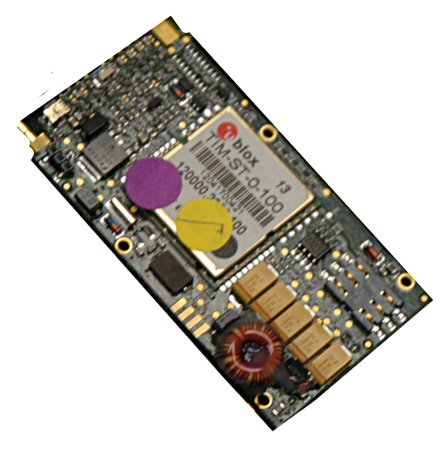Device Profile: Astrata GLP (Sirius-Lite) vehicle tracking device
Dec 21, 2004 — by LinuxDevices Staff — from the LinuxDevices Archive — 27 viewsA fleet management services company has used embedded Linux to radically improve its newest vehicle tracking device. Astrata's Linux-based GLP (formerly “Sirius-Lite”), which launched in October, features least-cost routing, uninterrupted operation during OTA (over-the-air) updates, and user customization through an SDK (software development kit).

The GLP can be easily concealed
Astrata provides vehicle tracking and fleet management services to major trucking lines and government entities, it says, and the GLP is not available separately from the company's services. The device is an eighth-generation product, but the first to use embedded Linux — older versions used machine code, and operated without an OS. About 2,500 of the devices are currently operating in the field, according to Astrata's managing director of telematics, Derek Wasson.
What'll she do?
The GLP is a diminutive device — “half the size of a cigarette pack,” the company says — designed to fit inconspicuously into vehicles. It is based on an unspecified ARM9 processor, and includes configurable amounts of Flash and RAM.

The GLP is based on an ARM9 processor
(Click to enlarge)
The GLP accepts a wide range of power inputs, from 8 to 32V, and also includes a 24-hour battery backup, useful for tracking down stolen vehicles that have had parts of their electrical system disabled, according to Wasson, who adds that Linux's high-level, intelligent power management features helped the company reduce power usage.
The device includes a sensitive GPS receiver that Wasson describes as “almost immune” to urban canyon outages. “It uses a GPS chip that is more advanced than anything that was available even six or eight months ago,” Wasson says. Wasson adds that inertial-based navigation capabilities based on vehicle instrumentation such as speedometers are being trialed for an unspecified government client.
The GLP uses its built-in GPS receiver to discover vehicle location and speed, at intervals as short as one second. The device also supports a range of external sensors, including load weight sensors and closed-door sensors. It offers four digital inputs, two digital outputs, two analog inputs, and a full-speed RS-232 port. This enables the device to intelligently adjust its configuration depending on whether the vehicle is unloaded, loading, or loaded, Wasson says.
Data are transmitted to a central location, using the cheapest of several available communications options, in batches as frequent as every 10 seconds. Wasson notes that using Linux greatly expanded the device's networking capabilities. “Linux enabled us to make the device communications agnostic,” says Wasson.
The company has so far developed dual-band and tri-band GSM/GPRS modules, including support for the 900/1800 bands and 1800/1900 bands, with modules for other cellular protocols such as CDMA under development, Wasson says. The device also supports communications via Internet SMS (short message service), and a module for satellite-to-satellite communications is in the testing phase of development, Wasson says.
According to Wasson, the device is able to determine the least expensive way to upload batches of data, and even to change data-gathering and upload frequencies accordingly. Wasson explains, “One of the beauties of Linux is least-cost routing. For example, a truck is driving from Seattle to New York. A low-cost GPRS channel is available, so we store one position every second, and send one batch every minute. Next cheapest service is SMS, but now we have a different reporting cycle, with positions every minute, and 10-minute batch uploads. If high-speed circuit-switched data [satellite communications] is the only channel available, we might only send exceptions.”
Exceptions are triggered by events such as rapid braking or acceleration, abnormal speeds, or departures from a preset route, Wasson explains, and can help ensure accident information is recorded and collected.
Another advantage embedded Linux brings to the tracking device is the ability to do OTA (over-the-air) updates to applications without interrupting service. “With machine code, we had to replace the entire firmware image,” Wasson notes.
Furthermore, the familiar programming environment provided by Linux enables Astrata's larger clients to develop their own software for the device, using a C++ SDK (software development kit) with a high-level API. “The Penske's of the world have their own IT and programming divisions,” Wasson notes.
Astrata developed the Linux operating system and application environment for the GLP internally, in eight months, with about 25 engineers and the help of an unspecified commercial Linux provider, according to Wasson. Astrata also received help from several Universities, says Wasson, who notes that the company is a preferred center for Fortune 50 companies to send training engineers to to learn about location-aware computing.
The GLP is available now as part of Astrata's range of telematics, geomatics, fleet management, and vehicle tracking services. The company offers various central management systems that include Web clients, to thin clients, to thick clients. Its thick-client central management software currently runs on Windows XP, but is written in portable code and will become available for Linux environments in about three months, Wasson says.
More details about Astrata's services and tracking devices are available on the company's website.
This article was originally published on LinuxDevices.com and has been donated to the open source community by QuinStreet Inc. Please visit LinuxToday.com for up-to-date news and articles about Linux and open source.